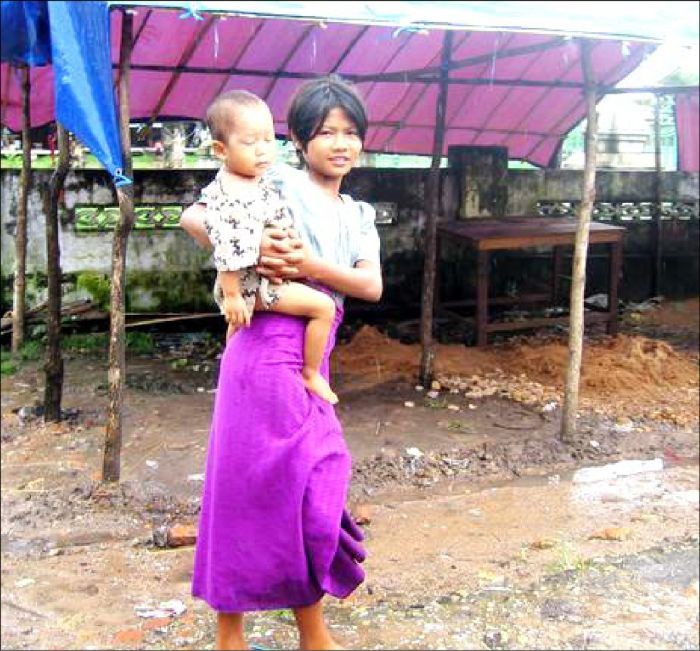
Marwaan Macan-Markar
To be a health worker along Burma’s eastern borders, home to the Karen and Karenni ethnic communities, is to court death, injury or imprisonment, say doctors working in the area. Even midwives have not been spared. One in her mid-50s was arrested and tortured, they add.
Such abuse by Burma’s military regime on health workers are only part of a grim picture in the border areas that have been laid waste by the junta’s policy of crippling the health and food distribution systems where the ethnic minorities live.
This continuing abuse has created a humanitarian crisis that places the Karen and Karenni victims on par with, or even worse than, victims in war-ravaged African countries like Rwanda, Somalia and Sierra Leone, say the doctors who are leading relief efforts inside Burma.
‘’Maternal mortality rates are higher than in Rwanda,’’ Dr. Mahn Mahn said at a news conference here earlier this week. ‘’The internally displaced people in eastern Burma face a chronic humanitarian crisis.’’
‘’Pregnant women cannot access obstetric emergency services. They cannot even have blood transfusions,’’ added Dr. Cynthia Maung. ‘’Health workers cannot carry medicines to help communities. They cannot be identified as health workers. It is very dangerous for them.’’
The doctors who are part of a novel health care service -- the Backpack Health Worker Team (BPHWT) -- made these comments at the launch of the first ever report on the health of internally displaced people (IDPs) in eastern Burma, where Rangoon’s troops are locked in a decades-old battle with ethnic rebel groups.
The maternal mortality rates (MMR) among the IDPs is between 1,000 - 1,200 deaths to 100,000 live births, states the 81-page ‘Chronic Emergency: Health and Human Rights in Eastern Burma.’ The MMR rates in Somalia, by contrast, is 1,100 deaths for every 100,000 live births, is 990 deaths in the Democratic Republic of the Congo (DRC) and 1,400 deaths in Rwanda.
The under-five mortality rate (U5MR) offers a similar parallel. In the ‘black zones of eastern Burma’ there are 221 deaths of children under five years for every 1,000 live births, the report adds, as against 283 U5MR in Sierra Leone, 260 u5MR in Angola and 205 U5MR in the DRC.
‘’Over a quarter of all families surveyed reported that part or all of their food supply (including fields, rice and livestock) had been taken or destroyed over the past year,’’ the report reveals. ‘’The systematic destruction of crops and food supplies by (Burmese) soldiers (is) to force villagers away from the hills and into (Burmese military)-controlled villages along vehicle roads.’’
‘’The maternal mortality rates and under-five mortality rates are key indicators to look at any country’s public health system,’’ says Dr. Voravit Suwanvanichkij, a researcher at the Centre for Public Health and Human Rights at the U.S.-based Johns Hopkins University. ‘’They measure the most vulnerable sections of a community.’’
‘’The report looks at areas considered ‘black zones’ and they are off limits to international aid organisations,’’ he added during an interview. ‘’The Burmese government has become more belligerent, putting road blocks to prevent humanitarian efforts, and forcing (the humanitarian agency) Medecins Sans Frontieres to pull out.’’
The BPHTW has, since 1998, tried to fill the void created by a crumbling public health system. It currently has 300 members who go in teams of two or three health workers for two-week visits at a time, spending about three days in each village. Besides reproductive health care, they offer medical assistance to victims wounded by gunfire and landmines, which also includes amputations done in bamboo-covered huts. The terrain they cover is hilly and heavily forested.
‘’Two of our doctors have been shot, seven have been victims of landmines,’’ Dr. Cynthia, a founding member of these medics working on the frontlines of a brutal conflict, told IPS. ‘’In the last six months, three of our workers were arrested and jailed. One mid-wife was captured with medical supplies and was tortured by the Burmese army.’’
This week’s report adds to the revelations made in March about the malaise in Burma’s health system due to lack of funding by the State Peace and Development Council (SPDC), as the junta is officially known. In 2004, for instance, the SPDC set aside only 22,000 U.S. dollars to deal with HIV/AIDS in the country, states the report by Bloomberg School of Public Health at Johns Hopkins University. Burma is estimated to have between 310,000 to 600,000 people with the killer disease and has the highest prevalence rates in South-east Asia.
The filaria disease control budget for the same year was 6,000 U.S. dollars, despite two million cases being reported annually in the country, that study added. Such policies, where the combined state investment for health and education was less than one dollar per person per year, have led to ‘’Burma’s very low ranking in the WHO (World Health Organisation) ... assessment of health care systems, where Burma ranked 190 out of 191 states, outperforming only Sierra Leone.’’
Humanitarian agencies working along the Thai-Burma border expect little change on the ground for the IDPs in the Karen areas, given the SPDC’s current military offensive against the Karen rebels that was launched in November 2005. The thousands who have been forced to flee their villages have added to the growing number of IDPs living perilously along Burma’s eastern borders.
There are close to 540,000 IDPs in Burma, more than the number of war-displaced found in other Asian countries, including Afghanistan, according to a Norwegian refugee agency. Of them, nearly 92,000 are ‘’hiding in the forests.’’
‘’No wonder these areas are off limits. No wonder the situation in these areas are hidden,’’ says Dr. Voravit, the researcher. ‘’This is the manifestation of consistent human rights violations.’’






